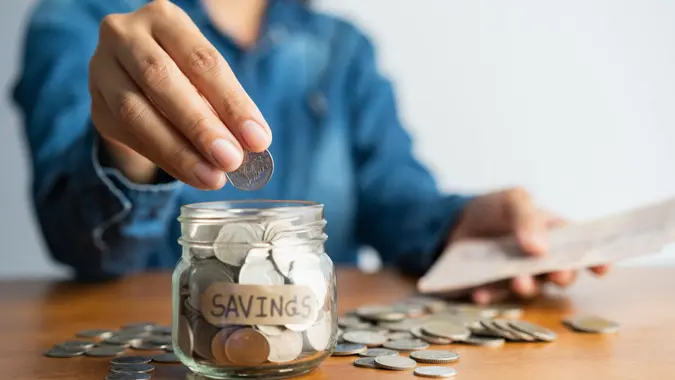How Much Americans Are Putting Toward Savings Each Paycheck

Commitment to Our Readers
GOBankingRates' editorial team is committed to bringing you unbiased reviews and information. We use data-driven methodologies to evaluate financial products and services - our reviews and ratings are not influenced by advertisers. You can read more about our editorial guidelines and our products and services review methodology.

20 Years
Helping You Live Richer

Reviewed
by Experts

Trusted by
Millions of Readers
As the cost of living in America continues to rise, many people are struggling to save. According to a recent GOBankingRates survey, 66% of Americans are “somewhat” or “extremely” stressed about their current level of savings, and 14% believe they will have to dip into their savings to cover expenses this year.
With many Americans straining their budgets, it’s no wonder that Americans are funneling very little of their paychecks into savings — if they’re saving anything at all. Here’s a closer look at how much Americans are putting toward their savings each paycheck.
Key Findings
- Many Americans (40%) have $250 or less in their savings accounts, with 18% having nothing saved.
- Over one-third of Americans (34%) don’t save any of their paycheck. Nearly the same amount (32%) save less than 10% of their paycheck.
- Gen X is the most likely to save none of their paycheck — 42% of Americans ages 45 to 54 said they live paycheck to paycheck and don’t put anything into a savings account.
Many Americans Have Dangerously Low Savings Account Balances
As a rule of thumb, it’s a good idea to have three to six months’ worth of living expenses in a liquid savings account to serve as an emergency fund — but many Americans have little to nothing saved. According to the GOBankingRates survey, 19% of Americans have nothing saved and 21% have between $1 and $250 saved. Only one-quarter of Americans (25%) have balances of $2,000 or more.
Older Gen Zers and younger millennials are the most likely to have nothing saved, with 23% of Americans ages 25 to 34 stating that they have $0 in their savings account. Boomers (ages 65+) are the most likely to have a healthy savings account balance, with 42% of Americans in this age range reporting that they have $2,000 or more in a savings account.
Living Paycheck to Paycheck Is Preventing Americans From Adding To Their Savings Account
Even though most Americans have insufficient savings, many are not able to add to their savings accounts. The survey found that the largest proportion of Americans (34%) contribute nothing from their paychecks into savings because they live paycheck to paycheck. About one-third (32%) contribute less than 10% of their paycheck into a savings account, 23% contribute 11% to 30% of their paycheck, 6% contribute 31% to 50% of their paycheck, and 4% save more than 50% of their paycheck.
Gen X is the most likely to save none of their paycheck, with 42% of Americans ages 45 to 54 reporting that they live paycheck to paycheck and don’t put anything into a savings account. Gen Z (ages 18 to 24) is the most likely to dedicate a significant percent of their paycheck to savings, with 10% contributing 31% to 50% of their paycheck to savings and 5% contributing more than 50% of their paycheck to savings.
What Percentage of Your Paycheck Should You Contribute To Your Savings Account?
The ideal percentage of your paycheck to save depends on your current financial circumstances — specifically, do you have a sufficient emergency fund or not.
“For those with no or insufficient emergency savings, I recommend allocating at least 10% to 15% of each paycheck to a high-yield savings account until reaching a minimum of three to six months’ worth of essential expenses,” said Melissa Murphy Pavone, CFP, founder at Mindful Financial Partners. “If that feels unattainable, start smaller — even 5% is better than nothing — and gradually increase as circumstances allow.”
Even if you have an emergency fund, Murphy Pavone still recommends dedicating a portion of your paycheck to savings to cover large expenses that could come up in the shorter term.
“If you already have a fully funded emergency fund, it’s still wise to direct a portion of each paycheck into savings for short-term goals like home repairs, vacations or large purchases,” she said. “Beyond that, extra funds might be better allocated toward retirement accounts, investment portfolios or debt reduction, depending on your personal financial goals.
“Ideally, individuals should aim to save at least 20% of their paycheck,” she continued, “with 10% to 15% going toward long-term investments, like retirement accounts, and at least 5% to 10% dedicated to short-term savings.”
Methodology: GOBankingRates surveyed 1,006 Americans ages 18 and older across the country between Dec. 6 and Dec. 9, 2024, asking 24 different questions: (1) What is your preferred method of banking?; (2) How optimistic are you that you will add more than $2,000 to your savings account balance over the next year?; (3) How much do you anticipate your savings account balance to change over the next year?; (4) How would you characterize your current level of stress when it comes to your current savings?; (5) How much is the minimum balance you keep in your checking account?; (6) How much do you currently have in your savings account?; (7) How much of your paycheck do you put in your checking account?; (8) How much of your paycheck do you put into your savings account?; (9) How satisfied are you with your current bank?; (10) What’s the worst part about your current banking situation?; (11) If you could change one thing about your current banking situation, what would it be?; (12) Which of the following bank accounts do you currently use/have open? (Select all that apply); (13) Which type of banking account do you trust the most to keep your money safe?; (14) Which type of banking account do you trust the LEAST to keep your money safe?; (15) Do you trust digital banks (neobanks, online-only banks) as much as traditional banks with physical branches?; (16) In the past year, how often have you written a physical check?; (17) When was the last time you chose to visit your bank in-person?; (18) Are you concerned about the rising number of physical bank branches that have shut down in the past few years?; (19) Have you had an overdraft on your checking account in the past year?; (20) How much cash do you keep at home?; (21) Do you believe the current banking system needs to change?; (22) Do you believe the current banking system benefits the rich more than the middle class or lower middle class?; (23) Do you believe the current U.S. banking system is unfair to Americans of lower economic status?; and (24) How have the results of the 2024 presidential election affected your financial outlook going into 2025 and beyond?. GOBankingRates used PureSpectrum’s survey platform to conduct the poll.
 Written by
Written by  Edited by
Edited by 

























